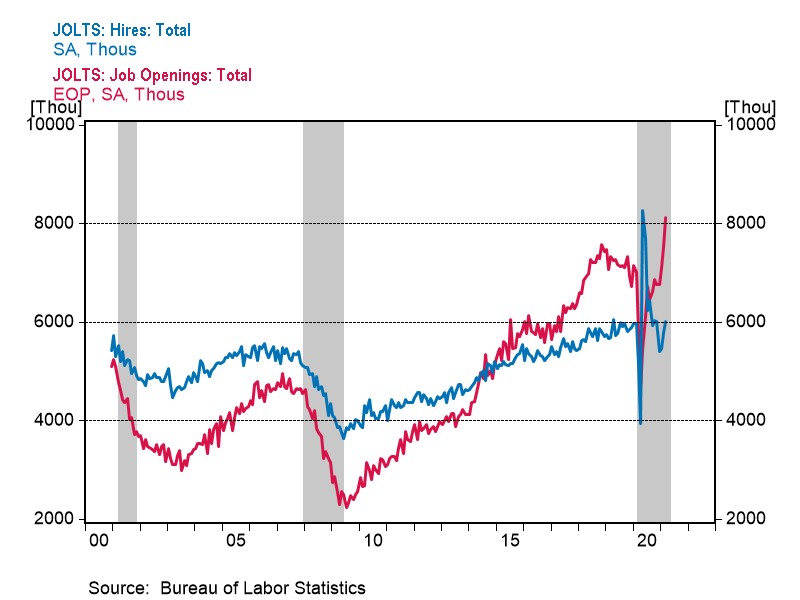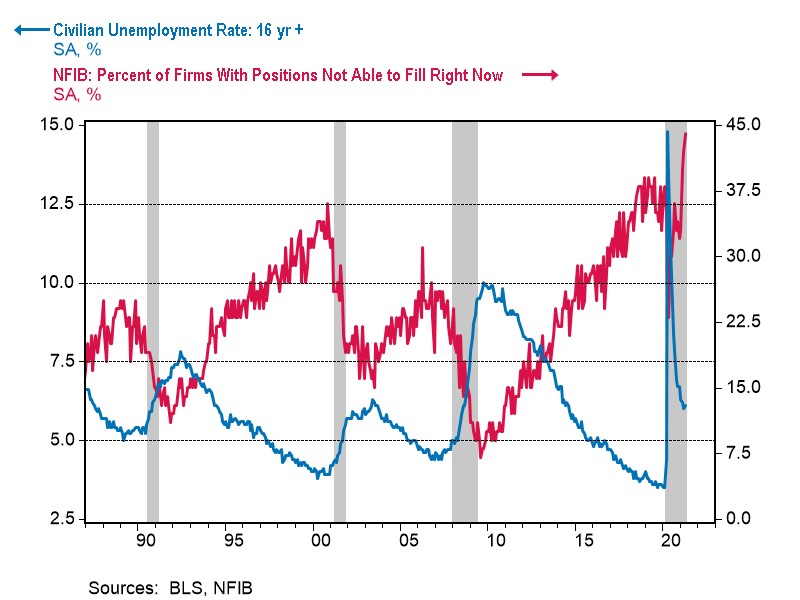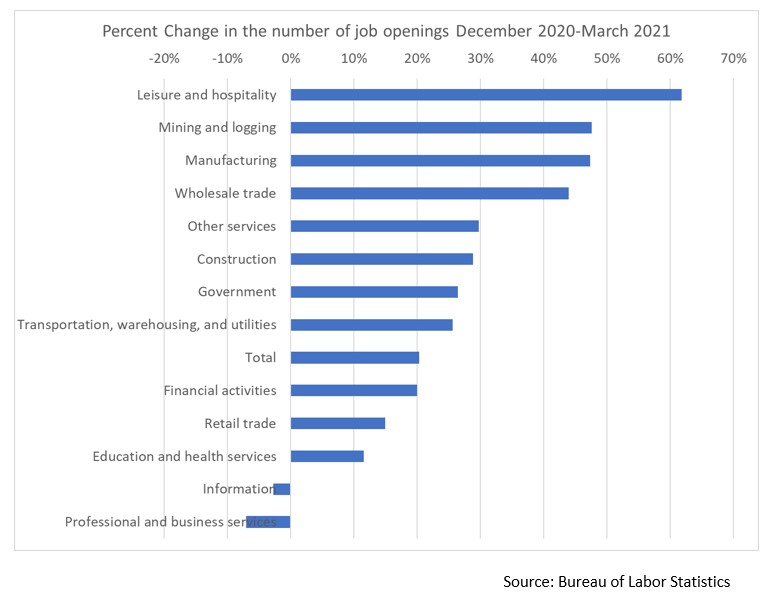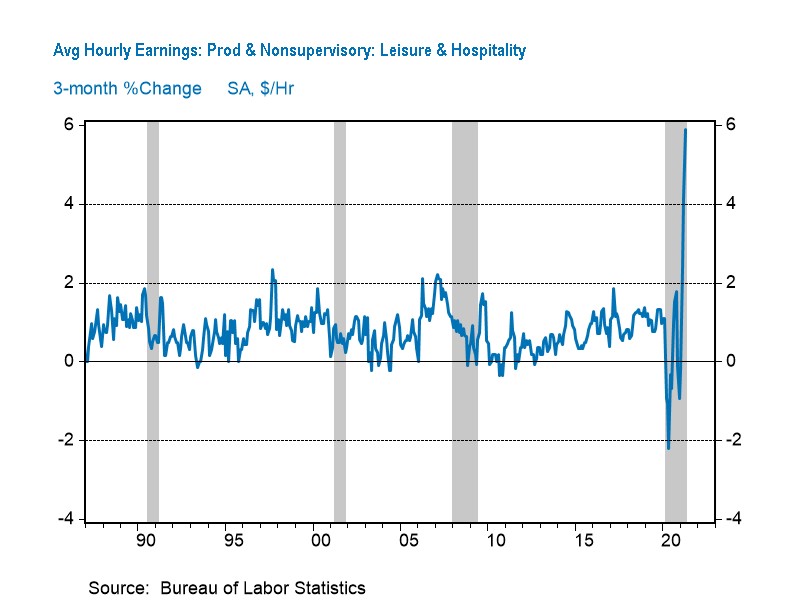
Despite still-elevated unemployment rates—and 8.2 million jobseekers waiting to be added to payrolls—labor shortages are back. As large segments of the economy continue to reopen at the same time, labor supply will be constrained, with these shortages likely to remain for the better part of 2021. Today, the Bureau of Labor Statistics released the results of the March 2021 Job Openings and Labor Turnover Survey. The number of job openings jumped 8 percent in March—and 20 percent over the past three months—to a record high of 8.1 million (chart below). The number of hires is growing much more slowly. The ratio between job openings and hires is a proxy for the average time to fill a job opening in the economy. It is now the highest ever and has been rising sharply in recent months. The difficulty of filling job openings is also reflected in a survey by the National Federation of Independent Businesses, also released today. Even with unemployment rates still hovering near 6 percent, the share of employers reporting open positions they are unable to fill reached 44 percent in April, a new record (chart below). The recruiting difficulties may partly explain the surprisingly low employment growth in April’s BLS jobs report. The increase in job openings was especially visible in industries that rely more on blue-collar and manual services workers (chart below). In particular, the leisure and hospitality sector (restaurants, hotels, entertainment, etc.) experienced the fastest growth in job openings as employers in these industries were able to increase activity as the economy opens up. Recruiting and retention difficulties are more pronounced in blue-collar and manual services jobs. While demand for these workers is rapidly growing, labor supply is constrained, because these workers face high infection risk and elevated unemployment benefits are an especially attractive option for workers with relatively low wages. In the leisure and hospitality sector, where most workers are women, the childcare crisis is another obstacle limiting the supply of workers. Companies are reacting to labor shortages by raising wages, especially in the leisure and hospitality sector. Average hourly earnings of non-supervisory employees in leisure and hospitality increased by six percent in the past three months, dwarfing any other period in recent decades (chart below). Some causes of the current labor shortages, including high unemployment benefits, fear of infection, and the childcare crisis, are largely temporary. So, labor shortages will probably ease as most people get vaccinated, children return to in-person schooling in the fall, and generous unemployment benefits expire in September. But a tight labor market may reappear as soon as late 2022. Massive job growth in 2021 will significantly lower the unemployment rate and tighten the labor market. And for the first time in US history, the working-age population is shrinking as many baby boomers are reaching retirement age. This will create increased demand and job opportunities for younger job seekers which would further lower the unemployment rate.



Retail Sales Show Consumers Stock Up ahead of Tariffs
April 16, 2025
US Seeks Shipbuilding Revival, Muting of China Dominance
April 14, 2025
March CPI May Hint at Consumer Pullback as Tariffs Rise
April 10, 2025
The US-China Trade War Escalates
April 09, 2025
Charts
Wage inequality continues downward trend in quarter 2 of 2023
LEARN MORECharts
Recent hikes in quits rates indicate retention difficulties across all industries, but have nearly approached pre-pandemic levels
LEARN MORECharts
Decline in office and administrative support work suggests certain tasks and skills have been replaced by automation
LEARN MORECharts
CEOs are having trouble filling positions as the unemployment rate drops lower
LEARN MORECharts
Non-union wages are growing faster than union wages
LEARN MORECharts
This index identifies the risk of future labor shortages for specific occupations.
LEARN MORECharts
Labor shortages and the tightening of labor markets have led companies to lower education requirements when recruiting.
LEARN MORECharts
The rapid rise in job openings to historic highs coupled with increasingly more workers quitting is leading to severe labor shortages, especially in leisure & hospita…
LEARN MORECharts
There has been a large increase in the share of office job ads that mention remote work since before the pandemic.
LEARN MOREPRESS RELEASE
Why the World Is Running Out of Workers
August 13, 2024
PRESS RELEASE
Report: As US Economy Grapples with Nearly 11 Million Unfilled Jobs, Immigr…
March 21, 2023
PRESS RELEASE
Difficulty Finding and Retaining Office Workers Skyrockets
May 05, 2022
PRESS RELEASE
CED Report Outlines Ways to Tackle Ongoing Labor Shortages
April 20, 2022
PRESS RELEASE
Tepid Job Gains Highlight Hiring Difficulties
June 04, 2021
PRESS RELEASE
Report: As COVID-19 Recedes, Labor Shortages Return as a Key Challenge for …
May 28, 2021
